Have you ever had your enthusiasm squashed like a bug on a windshield due to a rude email that landed in your inbox?
Rude emails tend to send us into a blinding rage. But before you grab your laptop and hurl it through a window, we suggest you take a deep breath.
Today, we’re talking about how you can maintain your composure, remain professional, and expertly deal with the rude person who’s on the other side of an unprofessional email.
So, let’s dive in!

Table of Contents
What constitutes a rude email?
Over the past couple of years, the number of emails we send out on a daily basis has skyrocketed.
In 2024, there was an increase of a whopping 4.1%, which brought the total number of emails sent to 361.3 billion. That number is expected to increase even more in 2025 to over 276 billion.
Now, there isn’t enough data that can tell us how many of those billions of emails were rude. Still, it’s only logical to assume that an increase in the number of daily emails a person receives leads to an increase in rude emails as well.
However, not all rude emails are the same. And, we don’t mean that some are mildly annoying while others make you contemplate the destruction of company property (although that might be a valid categorization as well).
Generally speaking, there are several different types of rude emails. Those are emails that:
- Use uncivil or condescending language and a demeaning tone,
- Use all caps or exclamation points to convey urgency and attract attention,
- Attack you on a personal level,
- Attack you on a professional level,
- Arrive in your inbox without any greetings,
- Overstep boundaries, and
- Are passive-aggressive.
However, for the purposes of this blog, we can divide all of these into two categories: actively and passively rude.
Type #1: Active rudeness
Actively rude emails are easy to define. There’s really no way that an actively unprofessional email leaves you wondering whether the person on the other end crossed a line or not.
Scenario #1: A rude opening
Sometimes, you might even see that an email is rude before you open it.
For example, suppose an email comes with a subject line like this: “URGENT!!!1 😡😡😡😡”.
In that case, you can immediately see that the person on the other end is so agitated that they decided to temporarily pretend like email etiquette isn’t a thing.
There are different variations of the example above where the sender might:
- Use your name in all caps as the subject line,
- Forgo all types of greetings (like a “hello” at the beginning of an email), or
- Just send an empty email with question marks in the subject line.
It doesn’t even matter what follows — with an opening like this, an email is bound to raise your hackles.
Scenario #2: Uncivil language and personal attacks
An email can still be actively rude even if it doesn’t have an atrocious subject line.
What’s more, even messages that we exchange with our coworkers via team communication apps like Pumble can be so unprofessional that they make us simmer with anger.
Those are usually messages that attack us on a personal level or even use impolite language like swearing, as shown in the example below.
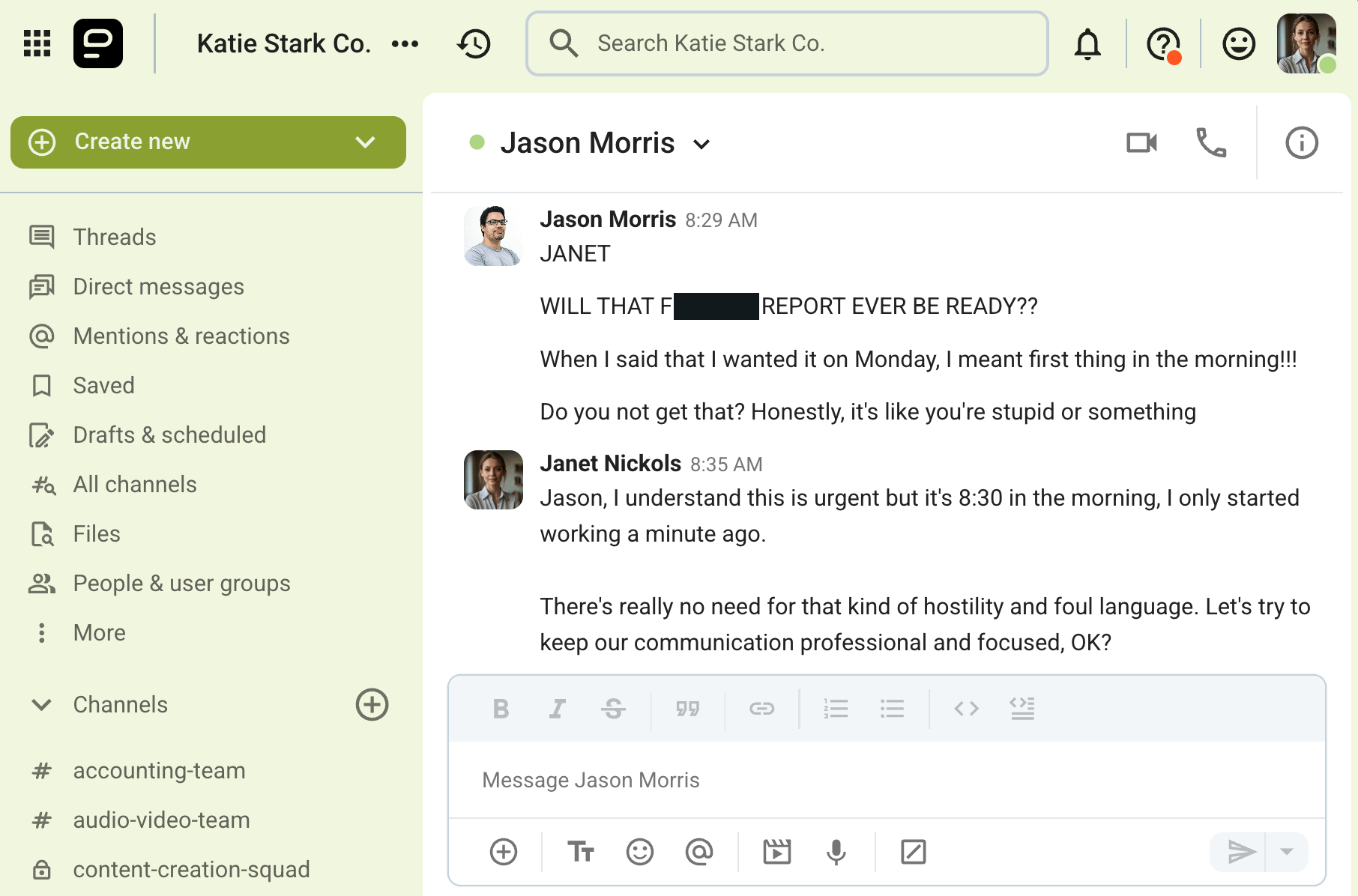
We can clearly see from the example above that Jason had an issue with Janet’s lack of (what he considers) a prompt response.
However, using vulgar language, as well as attacking Janet on a personal level and calling her stupid, definitely constitutes a rude and unprofessional message. It also might make Jason eligible for some anger management classes.
Resolve any workplace miscommunication seamlessly over Pumble
Scenario #3: Professional attacks
There’s also a chance that you find yourself reading an email or a message that’s a bit more subtle than the previous one.
For example, your boss or coworker might not attack you personally but instead question your professionalism or your ability to do your job.
Take a look at the Pumble exchange below to see how Milo chose a completely unprofessional way to tell Jessica that she did something wrong, thus implying she was negligent.
Type #2: Passive rudeness
Passively rude emails aren’t as “in your face” as those that arrive with caps-lock subject lines, for example.
A passively rude email might look friendly. It might seem like the other person is just trying to stay in touch or check up on you and your progress.
However, since there are right and wrong ways to check up on someone professionally, you’ll easily recognize when someone is being rude and when they’re just checking in with you out of the goodness of their own hearts.
Scenario #1: Passive-aggressive messages
Some of the most common passively rude emails people receive are the dreaded passive-aggressive messages. You know, the ones that make you roll your eyes so hard you gain the ability to see into your past lives.
According to one of our experts, Lisa Dawson, Director of Communications and PR, the question of how to respond to passive-aggressive emails is the hardest one of all:

“Passive-aggressive emails are the hardest because if there’s a vague undercurrent of hostility or blame, it’s unclear how to respond. You have to tiptoe around the ‘issue’ without creating more tension. If the email is beyond the scope of what you think is warranted in the situation, consider looping in a manager or HR. Remember, there’s a difference between a rude email and harassment.”
Passive-aggressive people usually use fake politeness or fake kindness to communicate their grievances with others.
For example, below you can see a message sent via Pumble’s DMs that seems polite and friendly but is, in fact, passive-aggressive.
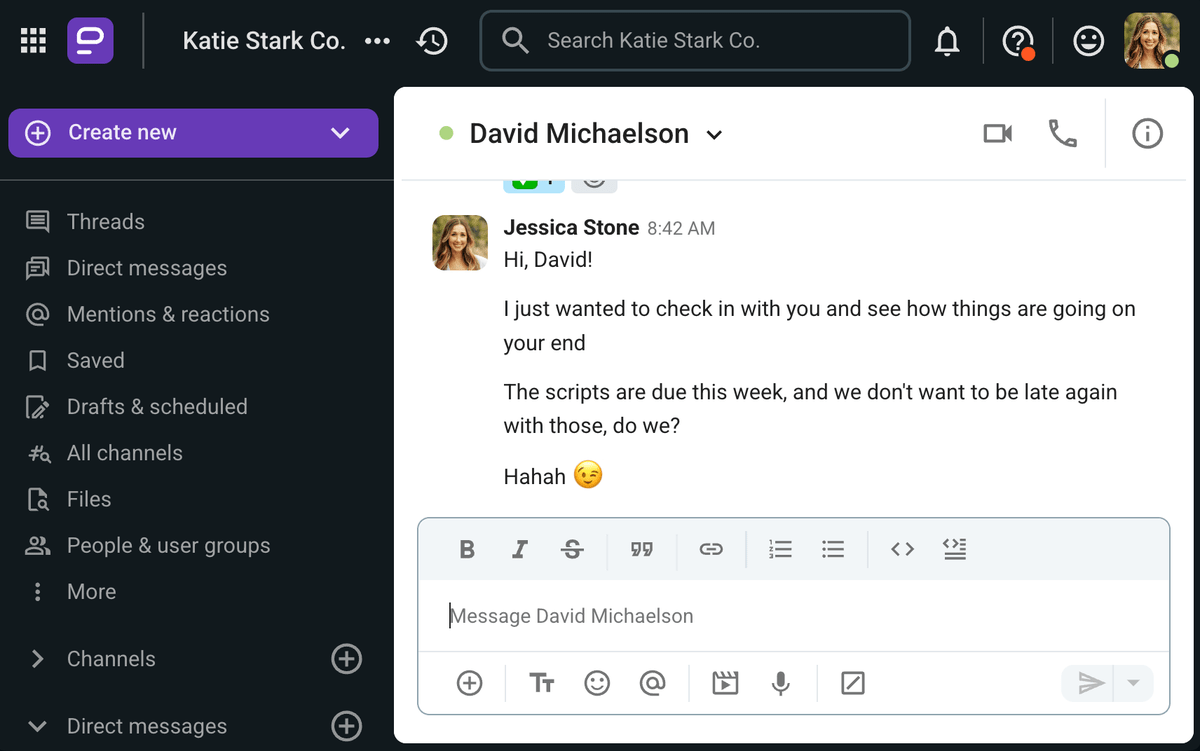
Aside from grating on people’s nerves, passive-aggressive messages also hinder effective communication and make it hard for people to collaborate efficiently. This makes passive-aggressive messages the most difficult to handle, as Sylvie di Giusto, Keynote Speaker, testifies:

“You find yourself second-guessing whether it was truly rude or if you’re overreacting, which adds a layer of emotional labor. It’s much easier to respond to overt rudeness than to something designed to poke without leaving fingerprints.”
💡 Pumble Pro Tip
Passive-aggressive communication is the least productive type of communication when it comes to solving conflicts. If you want to know more about how to deal with passive-aggressive coworkers, read the following blog:
Scenario #2: Overstepping boundaries
Sometimes we make a mistake and find ourselves reading a rude or passive-aggressive email that berates us for our error.
However, at other times, we find ourselves on the wrong end of an impolite message from a coworker, even though they were the ones who messed things up.
That’s often the case with coworkers and teammates who overstep their boundaries.
Having a teammate or coworker act as if they are above you in the hierarchy is a nuisance. Still, the biggest issue with these people is that they will almost always double down on their efforts to explain or justify their behavior.
Therefore, you might find yourself reading a passively rude message like the one Nathan got via Pumble, an internal communication app, below.
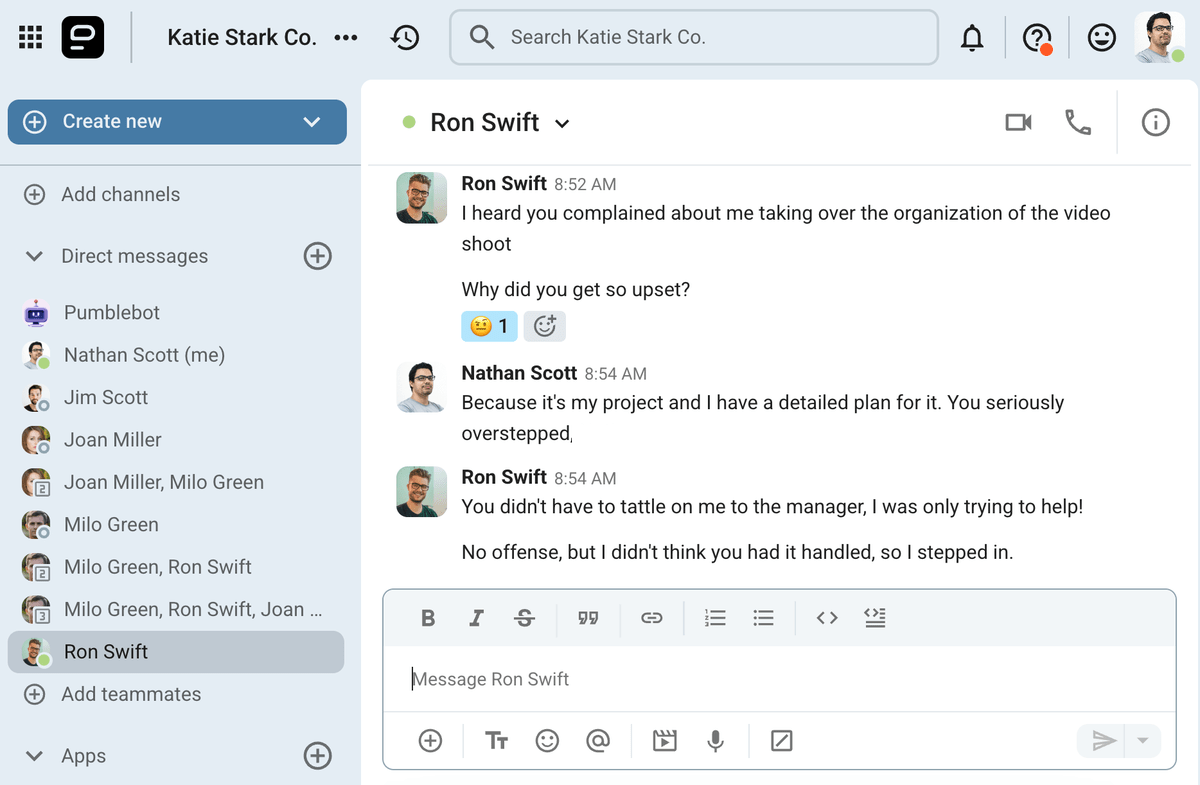
Scenario #3: Non-reply emails
Lastly, the final type of passively rude emails is a non-reply. There are a couple of types of these messages, where the person on the other end:
- Simply ignores your message, or
- Ignore a part of your message or one of your questions.
Although these non-replies might not seem as rude as an actively impolite (or even aggressive) email, they still fall under the umbrella of unprofessional correspondence.
Why do people send rude emails?
IIt’s much easier to answer the question of how to respond to a rude email professionally than it is to uncover the mystery behind the rude emails themselves.
But let’s give it a go nonetheless.
Thanks to the global growth of remote work, emails and communication via employee communication apps like Pumble have become more frequent.
However, what was supposed to facilitate the exchange of information seems to have made it easier for us to be rude to one another.
In fact, rudeness in the workplace has been on a steady incline for decades now.
Two studies, done in 1988 and 2016, show a staggering difference in numbers — in 1988, around 25% of employees claimed they were being treated or talked to rudely at work, while in 2016, that number climbed to 62%.
A 2025 study by the Pew Research Center shows that people have become more rude in general in the post-pandemic world — 47% of respondents said that people have gotten more rude in the past 5 years, and 20% of them think the behavior is a lot more rude than before.
One of the proposed reasons for this massive rise in numbers is the fact that the ways we communicate with our coworkers have changed.
In the digital age, we rely on written, electronic communication to relay even the simplest messages and pieces of information to our colleagues.
And, apparently, it’s much easier to be rude to someone when you’re hiding behind a screen than it would be face-to-face.
Aside from that, you might find yourself on the receiving end of rude emails because the person sending them is:
- Lacking in the social skills department,
- Egotistical and therefore crass, or
- Unaware they are being rude due to having a different communication style.
Reason #1: They lack the necessary social skills or personal resources
A person who isn’t particularly socially adept probably doesn’t know where the line between “appropriate” and “rude” falls.
For example, someone who’s not that good at interpersonal communication might not see an issue with the following message.
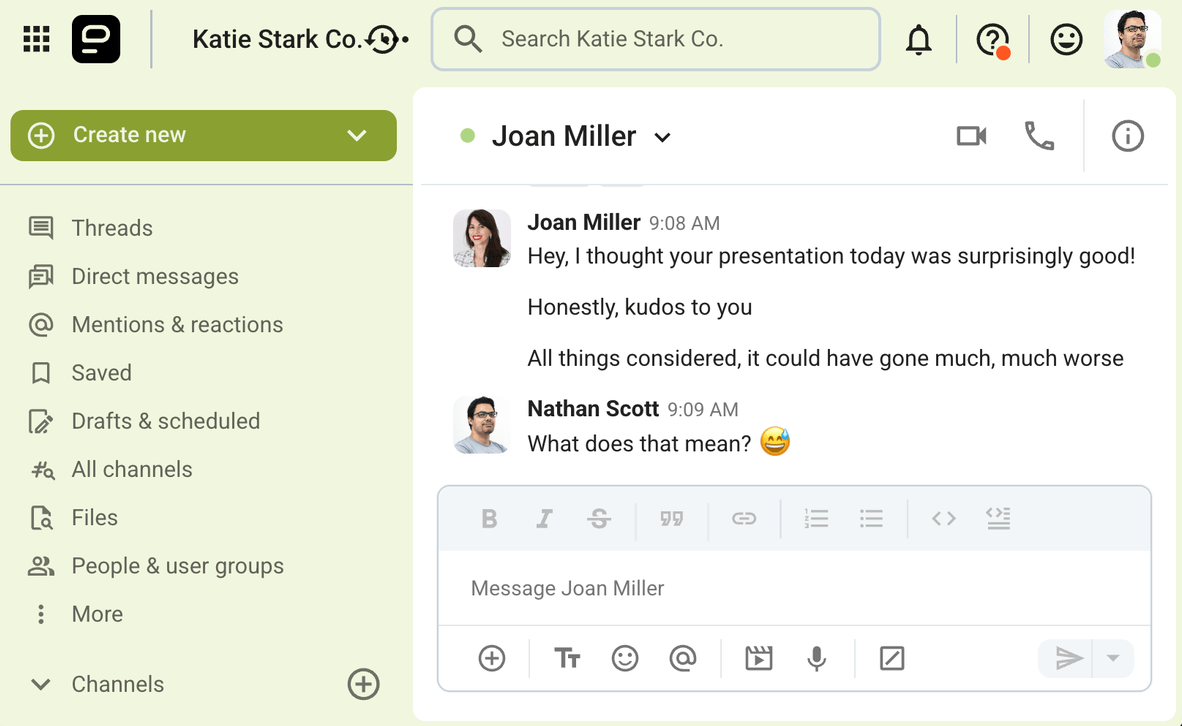
Exchange praise with your coworkers effortlessly over Pumble
You might read that message as condescending and even as a microaggression, but Joan might have been trying to pay her coworker a compliment without reading too much into how her words might come across.
Of course, it’s not just the socially awkward people who have trouble composing polite messages. People who lack personal resources might also find themselves struggling.
For example, if someone is on a tight deadline and is doing their best to achieve the unachievable, cramming 15 hours of work into a single workday, they might not have time for long, polite emails. If they are in “get things done” mode, they might just reply to inquiries with quick, concise answers so they can get on with their more pressing work.
Therefore, they might be unaware that they are being impolite.
Reason #2: They are egotistical
The second reason people send rude emails is probably the simplest one of all — they are rude.
People who have a tendency toward egotistical behavior are usually pretty confident in not only themselves but also their position, which allows them the self-given freedom to not censor themselves.
Alternatively, egotistical people might also think their needs (or tasks and issues) are more important than anything else.
Reason #3: They have a different style of communication
Let’s say you messaged a coworker asking them for clarification on something and received a one-word reply.
Now, most people would consider that rude.
However, stop to think whether that’s their usual style of communication.
We all have different styles of interpersonal communication. In other words, we all tend to have our own little quirks when it comes to how we communicate.
If the coworker in question (the one-word answer one) usually tends to stick to short answers in person as well, you can’t really blame them for sending out a “rude” email.
Food for thought: Is it really rude?
Electronic communication can oftentimes be difficult to interpret because it’s distant and detached. Remote workers, in particular, struggle with electronic communication (that’s also the main reason email isn’t ideal for remote workers).
More often than we’d like, our jokes or sarcastic remarks don’t read as well-intended on paper (or screen) as they would sound in person.
Take a look at the example below, where one person’s sarcasm wasn’t interpreted as they probably hoped it would be.
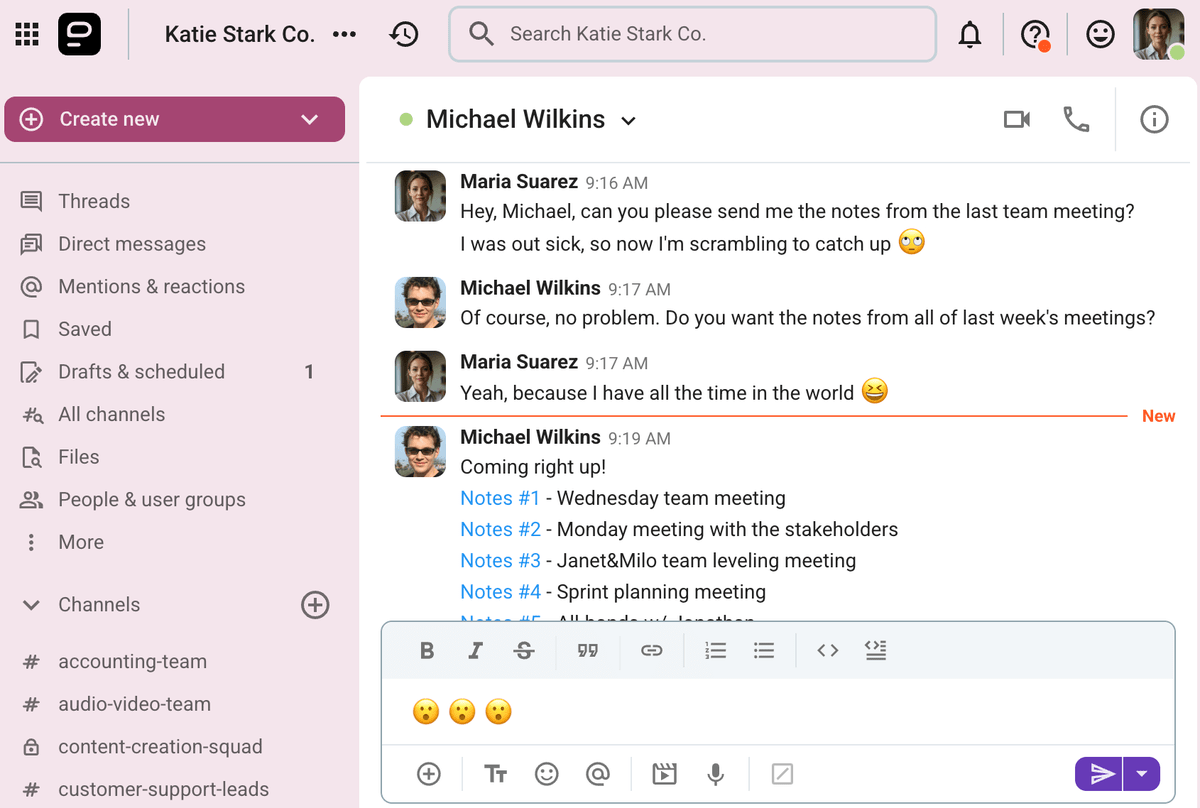
Maria probably regretted her poorly worded message the second Michael drowned her in emails with all the meeting minutes from last week’s meetings.
But, hey, she said she has all the time in the world, right?
This is a classic case of miscommunication or, better said, misinterpretation of a sarcastic message.
Therefore, when you receive a message you interpret as rude, ask yourself — is this really rude, or did something get lost in translation?
💡 Pumble Pro Tip
Are you wondering whether your messages at work are being misinterpreted? If that’s the case, then perhaps it’s time to hone your chatting skills. Here are some tips on how to do that:
Why even bother responding to a rude email in a professional manner?
When thinking about how to respond to a rude person professionally, many people wonder, “Why should I be polite when they clearly can’t show me the same courtesy?”
And while we understand the urge to deliver a tit when you receive the proverbial tat, there are 4 reasons you shouldn’t:
- To stay employed. Sometimes, we don’t have the luxury of being rude to someone (for example, when your boss or a big client is being rude to you). The best you can do is advocate for yourself.
- To work on your patience. No matter your industry, patience is a skill you definitely need at work (especially if you work with people). Instead of being rude back, practice assertive communication.
- To practice your people skills. Being able to respond in a polite manner, even when faced with an obstacle like an unprofessional email, is a great soft skill to have.
- To gain respect. Maintaining composure and a professional tone when confronted with a rude message will help you gain respect from both your peers and those above you in the professional hierarchy.
Tips for responding to a rude email (before you actually respond)
Now that we’ve figured out what constitutes a rude email and why you should bother maintaining your composure, it’s time to get to the nitty-gritty of today’s topic — how to respond to a rude email professionally.
It’s important to know that there is no sample response to rude emails that will help you deal with every situation where you receive rude messages.
However, there are some tips you can use that will help you craft the perfect reply.
Tip #1: Take a deep breath
The first tip we have for you might sound annoying, but it’s actually helpful.
As advised by Dr. Jay L. Serle, LMFT, Clinical Psychologist, the first thing you should do is detach yourself emotionally and take a moment before replying.

“Make sure you are calm before you respond. When faced with an impolite email, the best thing you can do is take a deep breath.”
That gives you a few extra seconds that will (hopefully) stop you from making a rash decision (like typing out a dozen or so swear words and sending them back).
Tip #2: Maybe even step away
If the breathing doesn’t work, give yourself more time.
You can’t let your emotions rule you because getting into a heated argument over email or a team messaging app won’t do anyone any good, as our expert, Lisa Dawson, explained:

“It’s very easy to get caught up emotionally in a heated digital conversation, but you can use the time gap feature of asynchronous communication to your advantage. Don’t be tempted to fire off an immediate response.”
You’ll spend valuable time and energy arguing with someone without working on solving the issue at hand — which probably prompted the original rude email in the first place.
Tip #3: Re-read the email carefully
Once you’ve gotten your emotions under control, read the email again.
This will give you a chance to look at it objectively without the simmering cloud of rage that probably appeared the first time you read it.
Tip #4: Consider the contents
An email or a message can be rude and still make valid points. That’s why you must consider what the person on the other end is trying to say.
More often than not, there’s a problem or an issue they are trying to address.
If you receive an unprofessional message that’s calling you out on a mistake you made, you can’t completely discard the remark just because it came in like a wrecking ball and ruined your day.
However, if the mistake wasn’t yours, then make sure to prepare your defense. Gather all the evidence you might need in order to explain yourself.
Tip #5: Consider ignoring it (at least until you’ve calmed down)
Is the message you received urgent? If not, consider ignoring it.
Of course, this isn’t always an option. Sometimes, we simply can’t afford to ignore someone’s messages, no matter how rude they may be.
But if you can, delay responding to the message as long as you can. That might also give the person on the other side a chance to go back to it, re-read it, and maybe reword it.
Tip #6: Consider reporting it to HR (if it’s abusive or insulting)
If the message you received was not only rude but also abusive or insulting, consider escalating the issue to your manager or the HR team in your company.
Just in case, we’d also suggest making a copy of the email or a screenshot of the message in question.
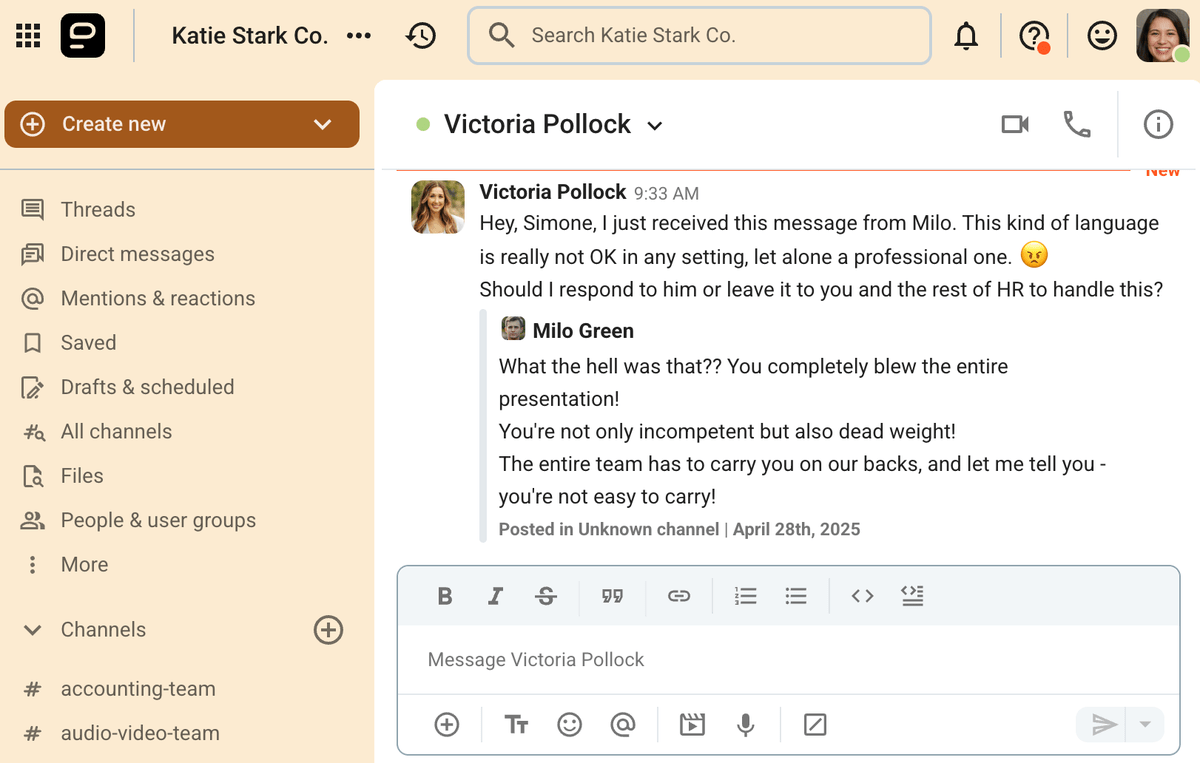
How to respond to a rude email: Examples you can use
If you followed all of our tips, you are now finally ready to come up with professional responses to a rude email.
To do that, all you need is a simple 5-step guide.
Step 1: Be polite
As mentioned before, the number one rule of responding to an angry email is to maintain your composure. So, start with a polite opening and maintain a professional tone.
Just because they were rude doesn’t mean you have to respond with rudeness, as our expert Sylvie di Giusto noted:

“Emotionally charged messages don’t deserve an emotionally charged reply. Acknowledge their tone without matching it. That way, you’re offering a path forward without accepting disrespect.”
Here’s how to politely respond to a rude email using the advice above:
“Thanks for the message. I can sense a bit of frustration on your end and would love to understand what’s causing it. That way, we can solve the issue in a productive way.”
“I understand that this is a difficult situation for you, but let’s try to keep our communication professional and focused, so we can come up with a suitable solution.”
Step 2: Be understanding
More often than not, you’ll find yourself on the nasty end of a rude email because there’s an issue or a problem that either requires your attention or that you’ve caused.
Own up to your mistakes or address the issue in a respectful manner. Show the sender that you understand the problem. Moreover, show them that you hold yourself accountable for the issue at hand.
Here’s an example of how you can do that.
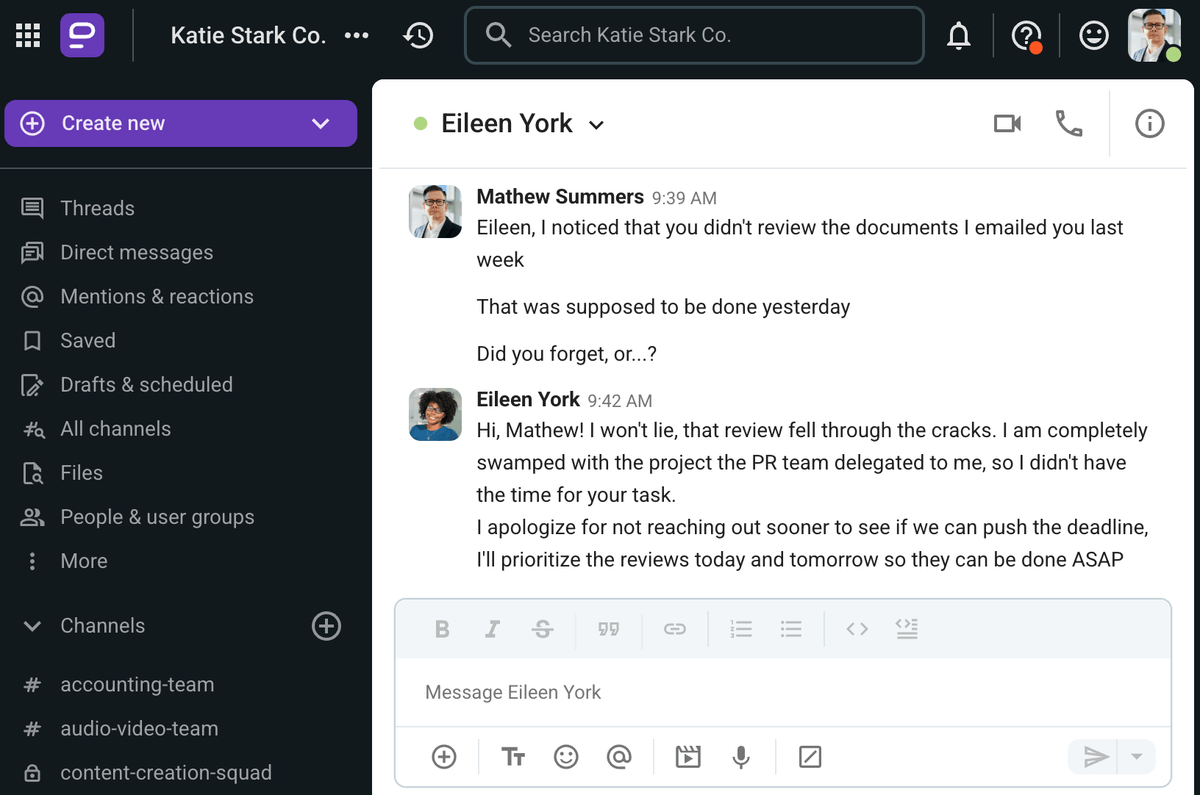
Below you’ll find a couple of other sample replies to rude emails and messages that you can use.
“I understand there’s an issue with X and that my mistake contributed to the situation. In the future, I’ll try to do Y to solve the situation before it becomes a problem.”
“I apologize for doing X (missing deadlines, making a mistake, etc.), I’ll rectify the situation immediately by doing…”
“I’m sorry for the issue that I inadvertently caused. Let’s try to work together on a solution that will allow us to move forward.”
Step 3: Maintain a professional tone
Ensure that you maintain a professional and respectful tone even when you want to be passive-aggressive (or just straight-up aggressive).
Remember, to stay professional:
- Keep your emotions in check,
- Don’t point fingers (and accuse the other party of being intentionally rude),
- Don’t get defensive, and
- Stick to the facts.
💡 Pumble Pro Tip
Interpersonal communication isn’t always easy, especially in remote teams. To ensure that you’re communicating clearly with your colleagues, brush up on your communication skills by reading the following post:
Step 4: Offer a solution
The most important step in replying to a rude message is addressing the original intent behind the message.
Keep a solutions-based mindset while writing your reply.
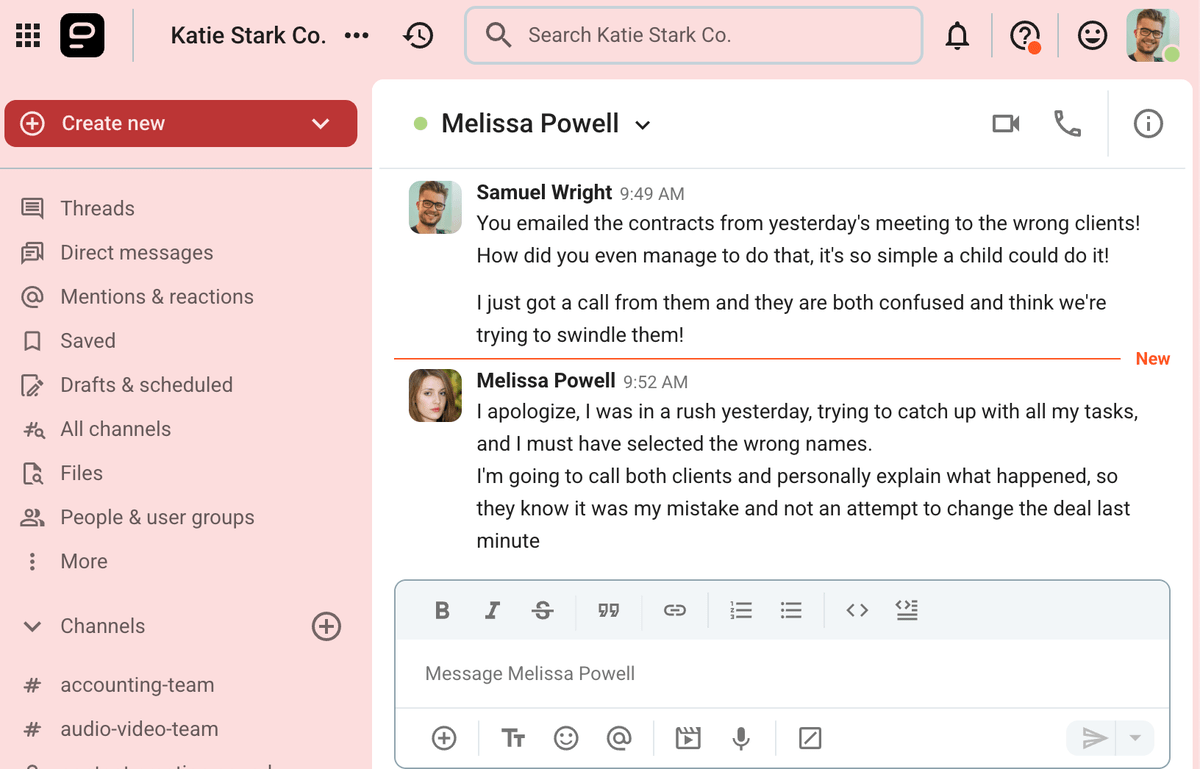
But sometimes, people send rude emails because they find themselves in a desperate position.
Faced with a problem, they become overwhelmed and temporarily forget that, even in dire circumstances, they are supposed to (at least pretend to) be professional. So, you end up with a rude email describing an issue that seems unsolvable to the sender.
Of course, if the issue at hand isn’t yours, you shouldn’t drop everything to solve other people’s problems.
However, offering a solution might help the person who sent the message see that their issue might not be as life-changing as they think it is.
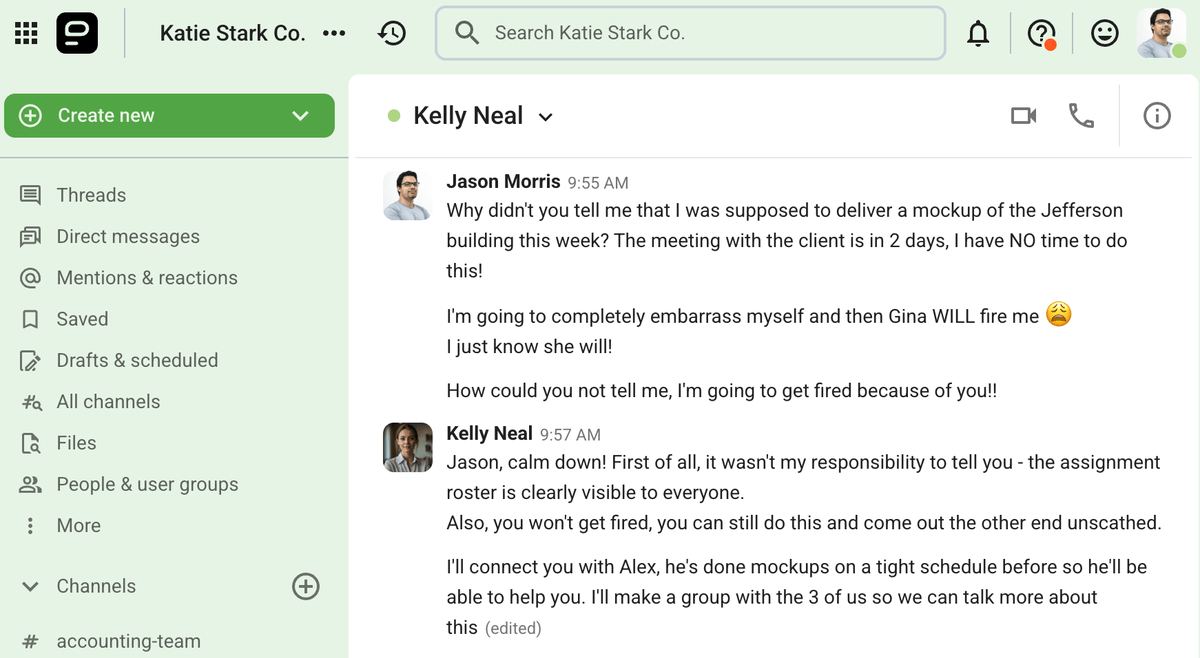
Step 5: End on a positive note
Since you maintained a professional demeanor the entire time, you should end your message in the same manner.
You can use some of these examples:
“Thank you for bringing this to my attention.”
“Thanks for checking in with me and letting me know about this problem.”
“I appreciate your reaching out to me about this.”
Ditch email and embrace streamlined and effective communication with Pumble
Additional tips on how to how to reply to a rude email professionally
Rude messages can increase your stress levels and lower your productivity.
At the same time, a professional demeanor and quick and efficient conflict solving are the fundamental factors that contribute to building trust in the workplace. That’s why it’s essential to be polite and professional.
With that in mind, pay attention to the following additional tips on how to respond to an angry email or a message.
Tip #1: Don’t create more drama
Being on the receiving end of a rude message isn’t a pleasant place to be. Still, your objective should be to deescalate the situation.
Therefore, don’t create more drama by adding more people to the discussion. Unless the email you received is particularly rude, disrespectful, or discriminatory in nature, don’t CC your manager or members of the HR team.
Try to resolve the issue with the person who sent the email as efficiently and quickly as possible.
Tip #2: Don’t share the email with other people
The urge to send your work BFF a message with a screenshot of the rude email is strong. We get it.
Still, you should resist it.
Sharing the rude message will just create additional drama or create office gossip. And that’s not really professional, is it?
Tip #3: Consider a more personal approach
As mentioned, digital communication can be distant and detached. We often say things differently in an email than we would in real life.
Electronic communication via email is also delayed. That’s why it’s sometimes prudent to seek out other means of communication.
Sometimes reaching out via a voice call, video call, or in person, or even using quicker and more efficient means of communication, like a business communication app, can help you resolve the issue quicker.
💡 Pumble Pro Tip
Are you unsure whether you should call your coworker or start a video call with them? Check out this Pumble blog:
Stay professional even in the face of rude messages — With Pumble
Hopefully, the tips, tricks, and examples we assembled for you in this blog post will help you stay as cool as a cucumber and politely and professionally reply to every rude email or message that dares darken your door (or your inbox).
But, to give you an extra helping hand, Pumble — a team communication and collaboration app by CAKE.com— has ensured you can stay respectful and professional when faced with rude messages.
Aside from a standard range of features that includes direct messaging, threads, voice and video calls, and messages, Pumble has 3 additional features that you’ll surely find helpful:
- Mute conversations so you can block out those coworkers who have gotten up on the rude side of the bed,
- No “Seen” option, so your rude coworkers won’t know that you’ve seen their message, giving you plenty of time to compose yourself and think of an appropriate response, and
- Edit messages feature — just in case you send a hasty (and overly rude) reply.
With Pumble, professional communication is a piece of cake! So make an account today!








